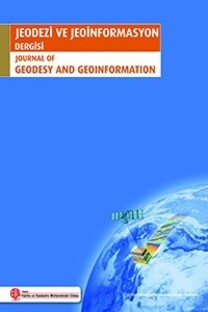Alternatif katı atık depolama alanlarının analitik hiyerarşi süreci ve coğrafi bilgi sistemleri ile otomatik olarak belirlenmesi: Sivas ili örneği
Türkiye’de birçok yerleşim biriminde devam eden altyapı projeleri sonucunda kentleşmenin ve kentleşmeye bağlı olarak da nüfusun artacağı düşünülmektedir. Bunun sonucunda katı atık miktarındaki artış da kaçınılmaz olacaktır. Bu çalışmada Coğrafi Bilgi Sistemleri (CBS) ve çok ölçütlü karar verme yöntemlerinden biri olan Analitik Hiyerarşi Süreci (AHS) kullanılarak, Sivas Merkez ilçesinde alternatif katı atık depolama alanları, geliştirilen kullanıcı arayüz programı yardımıyla otomatik olarak belirlenmiştir. AHS ile belirlenen ölçütlerin ağırlıkları hesaplanmış ve Sivas ili Merkez ilçesine ait veriler CBS’nin olanak tanıdığı coğrafi analizler yardımıyla sonuçlar ortaya konmuştur. Elde edilen bu sonuçlar doğrultusunda alternatif katı atık depolama sahaları önerilerek, mevcut katı atık depolama sahasının yerinin uygun olup olmadığı değerlendirilmiştir.
Anahtar Kelimeler:
Analitik hiyerarşi süreci, Coğrafi bilgi sistemi, Düzenli depolama alanı
Automatic determination of alternative landfill sites with analytical hierarchy process and geographical information systems: a case study in Sivas city
Due to the ongoing infrastructure projects in Turkey, it is estimated that the urbanization and population increase based on urbanization will increase. Therefore, the increase in the amount of solid waste will be inevitable. In this study, alternative landfills in Sivas, Central District, are determined automatically by using Analytic Hierarchy Process (AHP), one of Geographic Information System (GIS) and multi-criteria decision making methods, with a user interface developed. The weights of the criteria were calculated by AHP and the results were represented by the help of geographical analysis enabled by GIS depending on data of Sivas, Central District. In accordance with the results obtained, alternative landfills were proposed and the current location of the landfill was evaluated whether it is suitable or not.
___
- Akgün, A.A., Alkay, E., Kerimoğlu, E., Koramaz, T.K., Kundak, S., Okumuş, G. & Özçevik, Ö. (2014). Şehir Planlamada Analiz ve Değerlendirme Teknikleri (s. 132-147). Literatür Yayıncılık.
- Aksoy, E., & San, B. T. (2016). Using MCDA and GIS for landfill site selection: central districts of Antalya province. International Archives of the Photogrammetry, Remote Sensing & Spatial Information Sciences, 41.
- Aksoy, E., & San, B. T. (2019). Geographical information systems (GIS) and multi-criteria decision analysis (MCDA) integration for sustainable landfill site selection considering dynamic data source. Bulletin of Engineering Geology and the Environment, 78(2), 779-791.
- Atık Yönetimi Yönetmeliği. (2015, 04 Şubat). Resmi Gazete (Sayı: 29314). Erişim adresi: http://www.resmigazete.gov.tr/eskiler/2015/ 04/20150402-2.htm
- Başağaoğlu, H., Çelenk, E., Mariulo, M. A., & Usul, N. (1997). Selection of waste disposal sites using GIS 1. JAWRA Journal of the American Water Resources Association, 33(2), 455-464.
- Baban, S. M., & Flannagan, J. (1998). Developing and implementing GIS-assisted constraints criteria for planning landfill sites in the UK. Planning Practice & Research, 13(2), 139-151.
- Balca, Y. (2007). Düzenli depolama alanı belirlemede karar destek sistemi kullanımı (Doktora Tezi). İstanbul Teknik Üniversitesi Fen Bilimleri Enstitüsü Fen Bilimleri Enstitüsü, İstanbul, Türkiye.
- Güler, D. (2016). Analitik Hiyerarşi Yöntemi Ve Coğrafi Bilgi Sistemleri İle Alternatif Katı Atık Düzenli depolama Alanı Yer Seçimi: İstanbul İli Örneği (Doktora Tezi). İstanbul Teknik Üniversitesi Fen Bilimleri Enstitüsü, İstanbul, Türkiye.
- Hokkanen, J., & Salminen, P. (1997). Choosing a solid waste management system using multicriteria decision analysis. European journal of operational research, 98(1), 19-36.
- Kao, J. J., & Lin, H. Y. (1996). Multifactor spatial analysis for landfill siting. Journal of environmental Engineering, 122(10), 902-908.
- Lin, H. Y., & Kao, J. J. (1999). Enhanced spatial model for landfill siting analysis. Journal of environmental engineering, 125(9), 845-851.
- Lunkapis, G. J., Ahmad, N., Shariff, A. R. M., Mansor, S., & Mispan, R. M. (2004). GIS as decision support tool for landfills siting. In Map Asia Conference.
- Nas, B., & Berktay, A. (2002). Çevre problemlerinin çözümünde coğrafi bilgi sistemlerinin kullanımı. Coğrafi Bilgi Sistemleri Bilişim Günleri. İstanbul, Türkiye, 30-31.
- Ngoc, U. N., & Schnitzer, H. (2009). Sustainable solutions for solid waste management in Southeast Asian countries. Waste management, 29(6), 1982-1995.
- Sadek S., El-Fadel M. & El-Hougeiri N. (2001). Optimizing Landfill Siting Through GIS Application, Seventeenth International Conference on Solid Waste Technology and Management, Philadelphia.
- Siddiqui, M. Z., Everett, J. W., & Vieux, B. E. (1996). Landfill siting using geographic information systems: a demonstration. Journal of environmental engineering, 122(6), 515-523.
- Sumathi, V. R., Natesan, U., & Sarkar, C. (2008). GIS-based approach for optimized siting of municipal solid waste landfill. Waste management, 28(11), 2146-2160.
- Şener, Ş., Şener, E., Nas, B., & Karagüzel, R. (2010). Combining AHP with GIS for landfill site selection: a case study in the Lake Beyşehir catchment area (Konya, Turkey). Waste management, 30(11), 2037-2046.
- Türk, T., Gümüşay, Ü., & Tatar, O. (2012). Creating infrastructure for seismic microzonation by Geographical Information Systems (GIS): A case study in the North Anatolian Fault Zone (NAFZ). Computers & geosciences, 43, 167-176.
- Türk, T. (2013). Investigating environmental health studies using geographical information systems: cancer case study. Polish Journal of Environmental Studies, 22(5), 1505-17.
- Vasiljević, T. Z., Srdjević, Z., Bajčetić, R., & Miloradov, M. V. (2012). GIS and the analytic hierarchy process for regional landfill site selection in transitional countries: a case study from Serbia. Environmental management, 49(2), 445-458.
- Yal, G. P., & Akgün, H. (2014). Landfill site selection utilizing TOPSIS methodology and clay liner geotechnical characterization: a case study for Ankara, Turkey. Bulletin of Engineering Geology and the Environment, 73(2), 369-388.
- Yıldırım, Ü. (2012). Mersin ili için alternatif katı atık depolama alanlarının analitik hiyerarşi prosesi ve coğrafi bilgi sistemi yöntemleriyle saptanması (Yüksek Lisans Tezi). Mersin Üniversitesi Fen Bilimleri Enstitüsü, Mersin, Türkiye.
- ISSN: 2147-1339
- Yayın Aralığı: Yılda 2 Sayı
- Başlangıç: 2012
- Yayıncı: TMMOB Harita ve Kadastro Mühendisleri Odası
